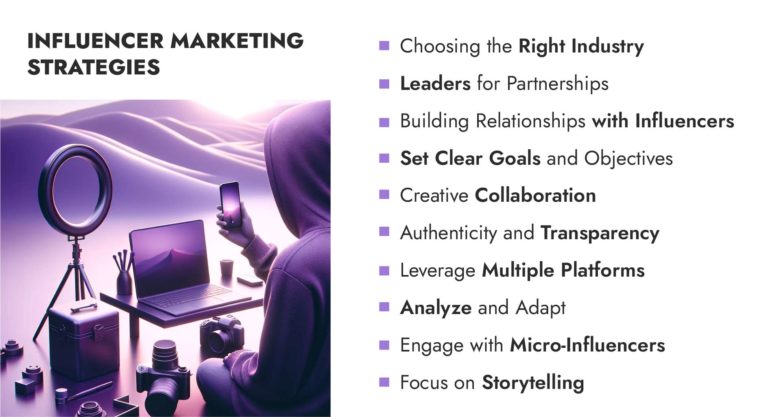Have you ever seen a famous YouTuber talking about a cool gadget and thought, “I need that!”? That’s influencer marketing in action — one of the digital marketing strategies for business growth! It’s like having a popular friend who tells you about the best stuff. This blog will take you through this exciting world with fun examples and easy-to-understand info. Let’s dive in!
What’s Influencer Marketing Anyway?
Imagine you’re at a party, and the most popular person there says they love a certain snack. Suddenly, everyone wants to try it. That’s influencer marketing — using popular people (influencers) to spread the word about your products. It’s not just about them having lots of followers, it’s about finding someone who fits your brand like a puzzle piece.
Strategies for Influencer Marketing
Partnering with industry leaders in influencer marketing involves aligning your brand with top influencers who are not just popular but also respected authorities in their respective fields. These partnerships can significantly elevate a brand’s status and credibility, as they bring the endorsement of well-regarded figures.
Let’s explore the best practices for influencer marketing that can help you maximize your efforts by collaborating with industry leaders.

1. Choosing the Right Industry Leaders for Partnerships
Look for influencers who are recognized as authorities in your industry. Identifying the right influencers is a crucial step in influencer marketing and hinges on two key aspects: understanding your audience and prioritizing relevance over reach.
Begin by researching who your customers are and the influencers they admire and trust.
This insight ensures that the influencer’s audience aligns with your own target market.
It’s important to collaborate with industry influencers and focus on an influencer’s relevance to your brand rather than their follower count alone. A smaller, niche influencer, who resonates more closely with your brand’s values and audience, can often be more effective than a celebrity with a vast but varied following. This approach ensures a more targeted and authentic connection with potential customers.
For example, if you’re a boutique organic skincare brand, your ideal influencer might not be a high-profile celebrity with millions of followers who covers a wide range of topics. Instead, a more effective choice could be a smaller, niche influencer who specializes in organic beauty and wellness, and has a dedicated following interested in natural skincare.
2. Building Relationships with Influencers
Aim for ongoing collaborations rather than one-off promotions. This builds more authentic connections. Ensure that the partnership is beneficial for both parties. An enthusiastic influencer can be a genuine brand advocate.
For example, a fitness apparel company might collaborate with a fitness influencer not just for a single campaign but over several months or even years. During this time, the influencer could participate in product launches, provide feedback for new designs, and share their fitness journey using the brand’s apparel.
Such an effective influencer partnership benefits both parties: the brand gains credibility and deeper audience engagement through the influencer’s consistent endorsement, and the influencer enjoys the perks of a steady relationship, like exclusive access to products and a solid partnership with a growing brand.
3. Set Clear Goals and Objectives
Is your goal to increase brand awareness, drive sales, or engage a new audience segment? Set measurable targets like engagement rate, conversion rate, or traffic to your website.
For example, if engaging a new audience segment is your goal, you might measure the success by analyzing the engagement rate (likes, comments, shares) within that specific demographic or monitoring the increase in traffic to a particular section of your website. These measurable targets not only provide a clear direction for your influencer marketing efforts but also offer tangible ways to evaluate the campaign’s effectiveness, allowing for adjustments and optimization as needed.
4. Creative Collaboration
Work with influencers to create content that aligns with your brand’s message but also fits their unique style and audience. Think beyond standard sponsored posts. Consider giveaways, Q&A sessions, live-stream events, or behind-the-scenes content.
A real-life example of creative collaboration in influencer marketing is the partnership between GoPro and adventure influencers. GoPro, known for its action cameras, teamed up with adventure sports enthusiasts, travel vloggers, and extreme sports athletes. These influencers used GoPro cameras to capture and share their thrilling experiences like skydiving, surfing, and mountain biking. This content wasn’t just promotional; it was genuinely engaging, showcasing the durability and quality of GoPro cameras in action-packed scenarios.
5. Authenticity and Transparency
You need to select influencers who know your products and services and understand how they benefit them. Authenticity resonates with audiences. Ensure that influencers disclose the sponsored nature of the content. Transparency maintains trust.
A notable example of authenticity and transparency in influencer marketing is the collaboration between the fitness apparel brand Lululemon and top yoga and fitness influencers. Lululemon carefully selects influencers who are genuine practitioners and enthusiasts of yoga and fitness, ensuring that these individuals truly believe in and use their products.
This approach lends authenticity to the influencers’ endorsements, as their recommendations come from personal experience and genuine appreciation for the brand’s quality and functionality.
6. Leverage Multiple Platforms
Different platforms reach different audiences. Use a mix of Instagram, YouTube, TikTok, Twitter, and blogs to widen your reach. Tailor your approach to each platform’s strengths and audience preferences.
An excellent real-life example of leveraging multiple platforms in influencer marketing is the strategy used by Coca-Cola for its #ShareACoke campaign. Coca-Cola customized its iconic cans with people’s names and then collaborated with influencers across various social media platforms to amplify the campaign’s reach.
By tailoring the content to suit the strengths of each platform — visually-driven posts on Instagram, storytelling on YouTube and blogs, and interactive engagement on Twitter — Coca-Cola successfully broadened the campaign’s appeal across different audience segments, making #ShareACoke a globally recognized and highly successful campaign.
7. Analyze and Adapt
Use analytics tools to monitor the campaign’s performance against your goals.
Learn from each campaign. What worked? What didn’t? Consider these insights and boost future campaigns.
8. Engage with Micro-Influencers
Micro-influencers often have more engaged audiences compared to mega-influencers. Collaborating with micro-influencers can be more budget-friendly and yield a higher ROI.
9. Focus on Storytelling
Encourage influencers to tell a story with your product, making the content more engaging and relatable. Stories create emotional connections, which can be more persuasive than straightforward product endorsements.
Key Benefits of Partnering with Industry Leaders

Partnering with industry leaders in influencer marketing offers several key benefits:
- Enhanced Credibility: Collaborating with respected figures boosts your brand’s trustworthiness.
- Broader Reach: Industry leaders often have a large, engaged audience, providing wider exposure.
- Quality Endorsements: Their endorsements are typically viewed as authentic and influential.
- Expert Insights: Gain valuable insights and feedback from experienced professionals.
- Strategic Networking: Opens doors to new business opportunities and connections within the industry.
Questions & Answers
- How do brand partnerships work with influencers?Like a collaboration! You provide the product, and they create content around it.
- How do you reach out to influencers for a partnership?Send them a message! Be clear, friendly, and professional.
- Why follow influencers when planning a new product?They help you understand what your customers might like.
- Is influencer marketing effective for B2B?Yes! It’s all about finding the right influencer in your industry.
Influencer marketing is like having the coolest person in school show up to your party. It can make your brand the talk of the town. Remember, it’s all about finding the right influencer, being genuine, and creating a partnership that benefits everyone. Ready to find your influencer match? Let the adventure begin.




